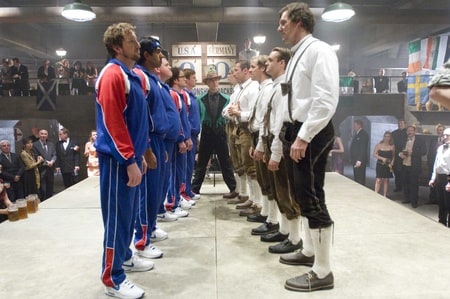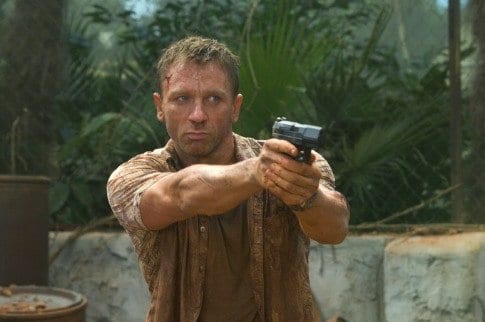Written and directed by the comedy troupe behind Super Troopers, Beerfest had the potential to be a laugh-a-minute comedy classic. After all, the entire picture revolves around beer: the brewing of beer, the consumption of beer, an international beer drinking competition, and beer-induced antics. Unfortunately, the finished product is a hit-and-miss affair, but it's good fun nevertheless and the gags that do fly are fairly funny. Beerfest is a love letter to alcoholism, carrying its R-rating as a badge of honour as it serves up bawdy, foul-mouthed humour whilst observing reckless drinking. Still, there's no getting around the lack of quality belly-laughs here, and there's no reason for the film to run a mammoth 110 minutes.

After the death of their grandfather, brothers Jan (Soter) and Todd (Stolhanske) travel to Germany to deposit the ashes. However, the boys are mistakenly introduced to Beerfest, an underground "Fight Club" style beer-drinking competition. Beaten and humiliated by the German team, Jan and Todd return home seeking to build a powerful beer-drinking squad and give the Germans their just desserts at Beerfest next year. To create their team of beer guzzlers, the brothers court several of their best drinking buddies: local glutton Landfill (Heffernan), science nerd Fink (Lemme) and male prostitute Barry (director Jay Chandrasekhar). With the team in place, they begin an intense year-long training regimen to prepare for the impending competition.
Broken Lizard made a splash with their 2002 cult favourite Super Troopers, but were maligned for their follow-up project, 2004's Club Dread. For Beerfest, the Lizard troupe opted to satirise the sports movie genre. Thus, screenwriters Chandrasekhar, Kevin Heffernan, Steve Lemme, Paul Soter and Erik Stolhanske filled Beerfest with sports movie clichés, from the concept of an underdog team wanting to prove themselves to slow-motion shots during the finale. Furthermore, Jan and Todd's underdog team is comprised of lovable losers who can only reach their full potential when working together, while the opponents are pure evil. Oh, and did I mention the period when the underdogs doubt themselves and begin to fall apart? There aren't a lot of surprises throughout the film due to its eagerness to parody the formula, and that's fine, but some sense of inventiveness would be appreciated. Fortunately, though, the final competition is awesome - it's drawn out to epic proportions, with the lads competing in every beer-related game imaginable.

Beerfest throws a lot of jokes at the wall, and a few of them do stick. However, by no means is this classy humour - it's low-brow (brau?) stuff, with Fink jerking off frogs and Landfill's twin letting off belches resulting in hurricane-level destruction. Broken Lizard formed in their college days, and it would seem that they still haven't grown out of their college-level mentalities. On top of this, there are a few fun movie references: characters make fun of Arnold Schwarzenegger's accent, there's a sly homage to First Blood, and the Fight Club nods are endless. However, with Beerfest running at almost two hours, Broken Lizard repeat themselves ad nauseam, and waste too much time burning through pages of superfluous exposition. The biggest blow against the film, though, is that it's just not as funny as it should have been. I guffawed a few times and I had fun with the flick, but it lacks show-stopping belly-laughs.
Playing the leads, Paul Soter, Erik Stolhanske, Kevin Heffernan, Jay Chandrasekhar and Steve Lemme all share a strong camaraderie, and it's fun to watch these guys interact. Heffernan is most notable as the beer-swilling chubster affectionately known as Landfill. Meanwhile, veteran actor Jürgen Prochnow also appears here, gleefully playing against type as the one proudly presiding over the German team. The Broken Lizard guys were smart enough to include references to one of Prochnow's most famous roles in the film Das Boot, yielding some of the best laughs in the film. Another veteran in the cast is Cloris Leachman as the boys' filthy great-grandmother. Leachman is astonishingly game here, being as raunchy as the script requires while also making the character seem somewhat grounded in reality.

Humour is very subjective, hence it's difficult to say whether or not someone will enjoy Beerfest. For this reviewer, it's a fairly funny movie, but it's not as hilarious as one might want. When the film works, though, it definitely does work, and the crude, R-rated material makes it ideal for college campus parties around the world. If you're hanging out with your buddies with beer and pizza, Beerfest will probably satisfy you.
6.0/10
 Login
Login
 Home
Home 183 Lists
183 Lists 1671 Reviews
1671 Reviews Collections
Collections
 0 comments,
0 comments, 


































